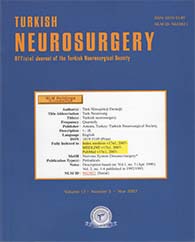Turkish Neurosurgery
2007 , Vol 17 , Num 3
The Effect of Laminectomy on Instability in the Management of Degenerative Lumbar Stenosis Surgery: A Retrospective Radiographic Assessment
1,3,4Department of Neurosurgery, Bak›rkoy Hospital for Psychiatric and Neurological Diseases, Istanbul, Turkey2Department of Neurosurgery, Istanbul University Faculty of Medicine, Istanbul, Turkey A retrospective study was conducted to assess the surgical outcomes of degenerative lumbar spinal stenosis. Thirty-four patients treated with decompressive surgery in Departments of III. Neurosurgery, Bakırkoy Hospital for Psychiatric and Neurological Diseases between 2000-2004 were reviewed. There were 13 males and 21 females. The average age was 57.5 (range 51 to 73 years old) and the average follow-up time was 23 (12- 60) mounts. The types of surgery consisted of standard single laminectomy. The surgical outcomes were assessed with dynamic radiographic investigation and more than 15 degrees were assessed as segmental instability. Average preoperative sagittal rotation angles were measured 3.5 degrees and average postoperative angles were measured 6.5 degrees. Only one patient (%3) with two level laminectomy and 17 degrees postoperative sagittal rotation angle showed a significantly poorer clinical outcome and accepted instable. This study showed that, treatment of degenerative lumbar stenosis can be safely and effectively performed with standard laminectomy alone, resulting no significant sagittal plane instability. We concluded that single decompressive surgery offers satisfactory results in degenerative lumbar stenosis. Keywords : Decompressive laminectomy, Degenerative lumbar stenosis, Instability spinal stenosis





